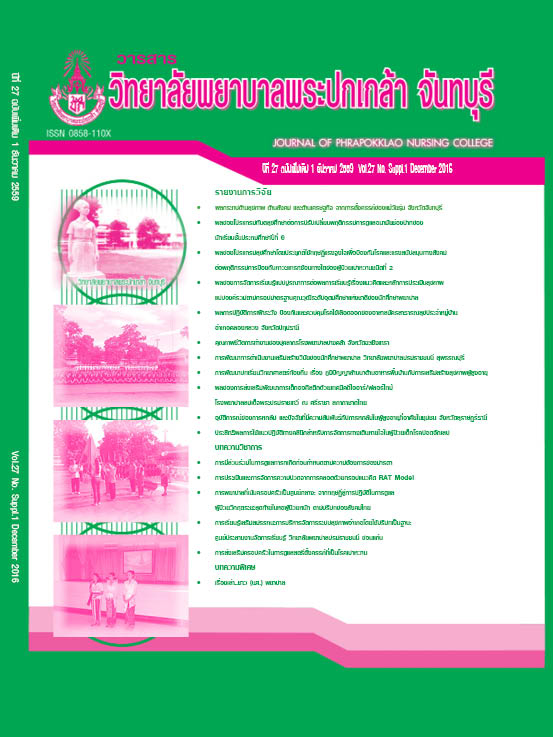Effects of Development Promotion based on DIR/Floortime Techniques in Autistic Children, Queen Savang Vadhana Memorial Hospital
Keywords:
Development promotion, Autistic children, DIR/Floortime techniquesAbstract
This quasi-experimental research aimed to examine the effects of development promotion based on DIR/Floortime Techniques. Samples consisted of 11 autistic children and their parents who were the clients of Queen Savang Vadhana Memorial Hospital. The research instruments composed of a handbook for development promotion based on DIR/Floortime Techniques, a record form for autistic children behaviors, an assessment form for results of treatment, an assessment form for basic development based on DIR/Floortime Techniques, and a descriptive assessment form for development based on DIR/Floortime Techniques. The implementation and data collection were conducted from October, 2013 to March, 2015. Statistics used for data analysis included frequency, percentage, mean, standard deviation, and paired t-test.
Results revealed that at 6-month, 12-month, and 18-month after entering development promotion activities based on DIR/Floortime Techniques, 1) autistic children had statistically significant higher total mean score of 1st-6th development than before entering development promotion activities (t = 11.002, p < .001; t = 5.857, p < .001 and t = 10.508, p < .001, respectively); 2) autistic children had statistically significant higher mean score of result of treatment for speech, language, and communication than before entering development promotion activities (t = 4.218, p < .01; t = 6.528, p < .001 and t = 6.708, p < .001, respectively); 3) autistic children had statistically significant higher mean score of result of treatment for sociability than before entering development promotion activities (t = 6.708, p < .001; t = 8.409, p < .001 and t = 14.861, p < .001, respectively); and 4) autistic children had statistically significant higher mean score of result of treatment for sensori-motor perception than before entering development promotion activities (t = 5.787, p < .001; t = 7.904, p < .001 and t = 13.416, p < .001, respectively).
This study suggested that health care providers and parents should continuously apply DIR/Floortime Techniques for activating development among autistic children.
References
กิ่งแก้ว ปาจรีย์. (2553). คู่มือการพัฒนาเด็กออทิสติกแบบองค์รวม (เทคนิค DIR/ฟลอร์ไทม์). กรุงเทพฯ: พิมพ์สี.
ทิศนา แขมมณี. (2557). 14 วิธีสอนสำหรับครูมืออาชีพ. กรุงเทพฯ: โรงพิมพ์แห่งจุฬาลงกรณ์มหาวิทยาลัย.
ปริศนา อานจำปา, และคณะ. (2556). ผลการส่งเสริมพัฒนาการนักเรียนที่มีภาวะออทิสซึมด้วยเทคนิค DIR/Floortime. สืบค้น วันที่ 12 พฤศจิกายน 2559, จาก http://www.autistickku.com/ARC/research_file/บทคัดย่อฟลอไทม์29กค56_8.pdf
วนาลักษณ์ เมืองมลมณีรัตน์. (2547). ความสัมพันธ์ระหว่างปัจจัยคัดสรร การสนับสนุนทางสังคม กับความสามารถในการดูแลบุคคลที่ต้องการพึ่งพาของมารดาเด็กออทิสติก (วิทยานิพนธ์ปริญญามหาบัณฑิต). มหาวิทยาลัยเชียงใหม่.
สำนักงานสถิติแห่งชาติ. (2553). การสำรวจประชากรพิการ. สืบค้น วันที่ 11 พฤษภาคม 2559, จาก www.nso.go.th
อิสรีย์ เขื่อนสุวรรณ. (2552). การออกแบบโปรแกรมส่งเสริมพัฒนาการเด็กออทิสติกตามหลักการของดีไออาร์ (วิทยานิพนธ์ปริญญามหาบัณฑิต). มหาวิทยาลัยเชียงใหม่.
American Psychiatric Association. (2000). Diagnostic and statistical manual of mental disorders (4th ed.). Washington: Author.
Greenspan, S. I., & Weider, S. (1998). The child with special needs: Encouraging intellectual and emotional growth. Reading, MA: Perseus Books.
Hess, E. B. (2012). DIR®/FloortimeTM: Evidence based practice towards the treatment of autism and sensory processing disorder in children and adolescents. Retrieved December 2, 2016, from https://www.novapublishers.com/catalog/product_info.php?products_id=52660
Lam, K. S. L., & Aman, M. G. (2007). Repetitive behavior scale-revised 3 years and older assesses restricted repetitive behaviors. Retrieved March 20, 2010, from https://books.google.co.th/baks?id=JnSJBAAAQBAJ&pg=PA26&dq=lam%aman,2007&source
Landa, R. (2007). Early communication development and intervention for children with autism. Mental Retardation and Developmental Disabilities Research Reviews, 13(1), 16-25.
Pajareya, K., & Nopmaneejumruslers, K. (2012). A one-year prospective follow-up study of a DIR/Floortime parent training intervention for preschool children with autistic spectrum disorders. Journal of the Medical Association of Thailand, 95(9), 1184-1193.
Rimland, B., & Edelson, S. M. (2000). Autism Treatment Evaluation Checklist (ATEC). Retrieved March 20, 2010, from https://www.autism.com/ind_atec
Tager-Flusberg, H., & Caronna, E. (2007). Language disorders: Autism and other pervasive developmental disorders. Pediatric Clinics of North America. Retrieved March 20, 2014, from https://www.bu.edu/autism/files/2010/Pedclinic2007proof1.pdf
Volkmar, F. R., et al. (2005). Autism and related disorders. Retrieved February 20, 2014, from https://www.ncbi.nlm.nih.gov/pmc/articles/PMC3848246
Downloads
Published
How to Cite
Issue
Section
License
Copyright (c) 2016 Journal of Phrapokklao Nursing College

This work is licensed under a Creative Commons Attribution-NonCommercial-NoDerivatives 4.0 International License.
เนื้อความ ข้อมูล และรายการอ้างอิงที่ผู้เขียนใช้ในการเขียนบทความเพื่อลงตีพิมพ์ในวารสารวิทยาลัยพยาบาลพระปกเกล้า จันทบุรี ถือเป็นความคิดเห็นและความรับผิดชอบของผู้เขียน คณะผู้จัดทำวารสารไม่จำเป็นต้องเห็นพ้องด้วยหรือร่วมรับผิดชอบ
บทความที่ได้รับการลงตีพิมพ์ในวารสารวิทยาลัยพยาบาลพระปกเกล้า จันทบุรี ถือเป็นลิขสิทธิ์ของวารสารวิทยาลัยพยาบาลพระปกเกล้า จันทบุรี หากหน่วยงานหรือบุคคลใดต้องการนำส่วนหนึ่งหรือทั้งหมดของบทความไปเผยแพร่ต่อเพื่อวัตถุประสงค์ใด ๆ จะต้องได้รับอนุญาตจากบรรณาธิการวารสารก่อน



